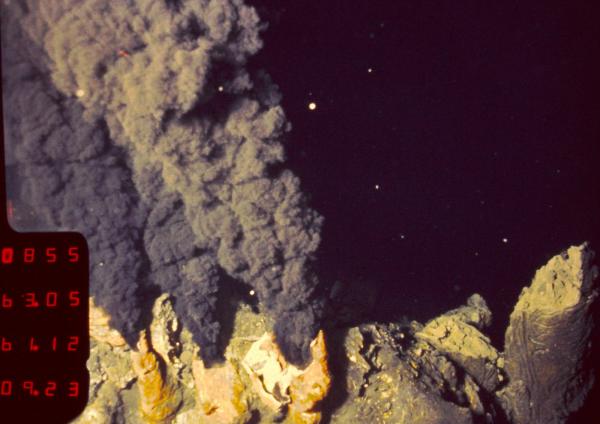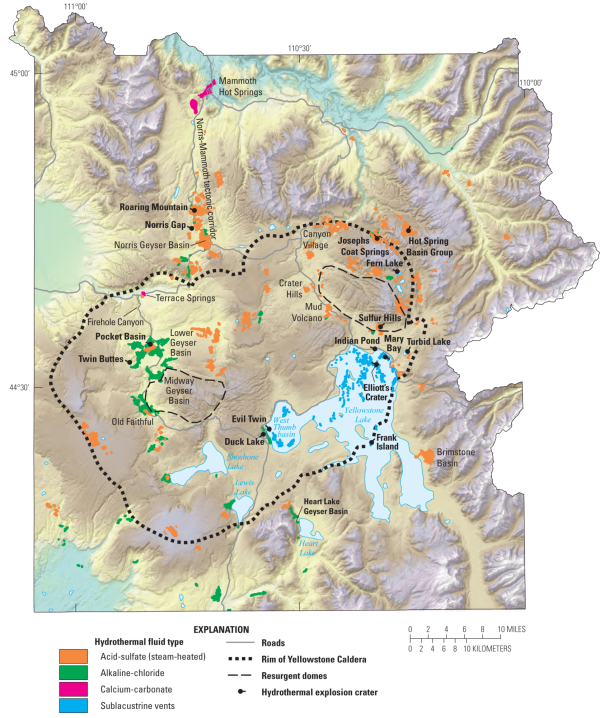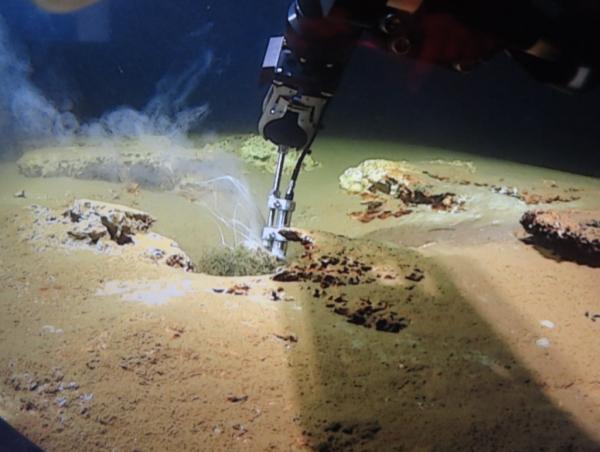Editor's note: Yellowstone Caldera Chronicles is a weekly column written by scientists and collaborators of the Yellowstone Volcano Observatory. This week's contribution is from Pat Shanks, research geologist emeritus with the U.S. Geological Survey.
Discovery of hydrothermal systems on the ocean floor in the late 1970s is regarded as one of the greatest scientific discoveries of the 20th century and has implications for the flux of chemicals and heat into the oceans, the formation of some mineral deposits, and the origin of life. Over the last 50 years, deep-ocean hydrothermal vents have been found along plate boundaries throughout the oceans of the world.

Photo of a deep-ocean hydrothermal vent system from the East Pacific Rise at 9º39’N latitude and 2550 m (8366 ft) depth showing vigorously venting “black smoker” hydrothermal fluids (329 °C, or 624 °F) that are dark gray to black due to rapid precipitation of iron, copper, and zinc sulfide minerals as the hot water mixes with cold bottom waters. Vent structures, referred to as chimneys, grow upward from the seafloor by precipitation of metal sulfide (dark gray) and calcium sulfate (white) minerals. Older sulfide deposits in the photo have been oxidized to yellow and orange colors due to reaction with cold (~1.4 °C, or 34.5 °F) oxygenated bottom waters/USGS, Pat Shanks, from the deep-diving submersible Alvin, in 1991.
Hydrothermal vents also occur on the floor of Yellowstone Lake, and the lake’s hydrothermal systems have been the focus of much recent research. USGS studies of hot springs on the floor of Yellowstone beginning in 1999 used multibeam sonar mapping and seismic reflection profiles of the lake floor coupled with direct observations using submersible remotely operated vehicles (ROVs). These studies discovered hundreds of vent craters related to previously active hydrothermal vents and dozens of currently active hot springs. More recently, the multidisciplinary “Hydrothermal Dynamics of Yellowstone Lake” project, which was funded by the National Science Foundation, the Global Foundation for Ocean Exploration, the National Park Service, and the U.S. Geological Survey, provided additional insight into the geology, geochemistry, and geophysics of the vent systems.

Map showing the location of active thermal areas categorized by hydrothermal fluid type and the location of large hydrothermal explosion craters (location shown with black dot and leader) with associated breccia deposits in Yellowstone National Park (locations from Morgan and others, 2009)/Figure modified from Lowenstern and Hurwitz (2008) and Morgan and others (2017).
Several different types of hot springs have been sampled by ROV on the floor of Yellowstone Lake. The deepest and one of the most active venting areas on the lake bottom, called the Deep Hole vent field and located east of Stevenson Island, had temperatures up to 174 °C (345 °F) and is driven by a vapor-dominated (H2O-CO2-H2S) zone that occurs about 15 m (49 ft) below the lake floor. In contrast, there are lake floor hot springs that have higher chloride content in Mary Bay, Elliott’s Crater, and in West Thumb.

Photo of ~141 °C (286 °F) lake-bottom hydrothermal vent from 53 m (174 ft) depth in West Thumb basin of Yellowstone Lake. Here, chloride-rich hydrothermal fluids vent from small channels (~10 cm, or 4 in, diameter) through the sediments on the lake floor. Generally, Yellowstone Lake vents produce clear fluids that are identified as shimmering hot water but, in this case, sulfur or silica precipitation from the venting fluid traces the pathway of fluid mixing with cold (~4 °C, or 39 °F) bottom water. Streamers of sulfur-coated bacteria extend from vents. Rock-like deposits on the lake floor represent hydrothermally altered semi-cemented muds/Image acquired by the Global Foundation for Ocean Exploration ROV Yogi on August 7, 2018.
So, how similar are Yellowstone Lake hydrothermal vent systems to the famous “black smoker” deep-ocean hydrothermal vent systems?
There are several commonalities. Both systems are heated by magmatic bodies at depth, with hot water rising buoyantly and transporting chemicals dissolved by reactions with hot and gases picked up from magma. In both types of systems, as deeply circulating and heated fluids rise toward the seafloor or lake floor, these fluids continue to react with surrounding rocks or sediments and cool. As pressure decreases, they can separate into two phases: a vapor-dominated gas-like fluid and a denser fluid with the properties of a liquid. Mixing colder fluids that circulate through the lake- or ocean-floor rocks may occur at any depth but is more common in the shallow subsurface or within the hydrothermal vents themselves. Hydrothermal fluids from either the seafloor or lake floor form buoyant plumes as they vent into the water column.
But the Yellowstone Lake and seafloor hydrothermal systems also have some important differences, including:
- Magmatic systems: Seafloor hydrothermal systems are usually underlain by shallow basaltic magma systems, usually 1–3 km (0.6–1.8 mi) deep, that have temperatures of 1175–1350 °C (2147–2462 °F). The rhyolitic Yellowstone system is cooler (650–850 °C, or 1202–1562 °F) and deeper (3–10 km, or 1.8–6.2 mi). As a result, circulating seawater beneath the seafloor can harvest much more heat than groundwaters beneath Yellowstone Lake and can therefore reach much higher temperatures.
- Water depth: the pressure on hydrothermal vents beneath a body of water relates directly to water depth. Oceans with depths of 100-5000 m (328–16404 ft) result in confining pressures from 10–500 atmospheres (1 atmosphere is the pressure experienced at sea level). In contrast, the deepest point in Yellowstone Lake is 120 m (394 ft), resulting in a pressure of ~12 atmospheres. The lower confining pressure in shallower water means boiling and phase separation are more prevalent, as seen in the Deep Hole vapor-dominated hydrothermal system.
- Temperature of vent fluids: In Yellowstone Lake, the maximum temperature of vent fluids is 174 °C (345 °F), compared to ~420 °C (788 °F) in the deep ocean. Respective fluid temperatures are even higher during deep circulation. These temperature ranges suggest that sub-seafloor systems may have more ability to alter rocks to hydrothermal minerals and to transport dissolved chemicals compared to the system beneath Yellowstone Lake.
- Composition of hydrothermal fluids: Hydrothermal vent fluids on the seafloor mostly are close to seawater composition (19,000 ppm chloride and abundant sodium, potassium, magnesium, calcium, sulfate, and bicarbonate), whereas the Yellowstone Lake hydrothermal systems incorporate essentially fresh water containing only about 5 ppm chloride.
- Water-rock reactions: Both seafloor and lake-floor hydrothermal fluids are chemically changed by heating and reacting with rocks in the subsurface. Contrasting rock composition reacting with the hydrothermal fluids produce dramatic contrasts in the hydrothermal fluid chemistry. Principal reactions with sub-seafloor basalt (high in magnesium and iron) produce fluids with high sulfide, iron, copper, and zinc and low silica. Reaction with rhyolite beneath Yellowstone Lake produces high silica and relatively low iron, magnesium, and sulfide fluids with high arsenic and other trace elements associated with rhyolite.
- Hydrothermal deposits at the vent site: One of the most striking contrasts is between hydrothermal deposits created on the seafloor and on the floor of Yellowstone Lake. The high sulfide, iron, copper, and zinc and low silica of the high-temperature seafloor vent fluids produces massive sulfide deposits consisting of minerals like pyrite, chalcopyrite, and sphalerite, with little or no associated silica deposits. In contrast, constructive lake floor deposits are rare and consist of almost pure silica when they do occur.
In summary, while they share general similarities, hot springs on the floor of Yellowstone Lake and on the seafloor have differences in physical (depth, pressure, temperature) and geochemical conditions (freshwater vs seawater; iron- and sulfur-rich basaltic rock vs silica-rich rhyolites) that result in vastly different chemical fluxes and deposits.

 Support Essential Coverage of Essential Places
Support Essential Coverage of Essential Places



